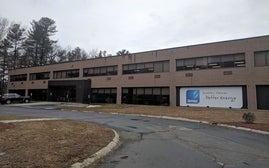After latest quarterly loss, can AMSC come back?
 File photo
AMSC lost $6.4 million in its latest quarter, which ended Dec. 31.
File photo
AMSC lost $6.4 million in its latest quarter, which ended Dec. 31.
It was a company that was flying high until, rather suddenly, its numbers began taking a southward dive.
AMSC, formerly American Superconductor, has been burning through cash since 2010, when the company's trade secrets were allegedly stolen by its largest customer. But as AMSC continues to strive for new markets, analysts and investors are left wondering how much longer the Devens-based manufacturer of energy technology can hold out.
AMSC lost $6.4 million in the latest quarter, which ended Dec. 31. With “under $6 million” in losses expected for the next quarter, the company has announced that it has enough money to fund operations through the end of 2015.
The company's problems began in 2010, when Chinese company Sinovel Wind Group refused to honor an extensive contract, costing AMSC $158.5 million when Sinovel refused to pay for past shipments or accept new ones. AMSC later brought the company to court for $450 million after Sinovel allegedly used a portion of the software code AMSC had developed for its wind turbines. (The case remains in the hands of the Chinese court system.)
“Everything was great until” that happened, said Theodore O'Neill, analyist for Ascendiant Capital Markets LLC, who covers AMCS. “They are still slogging it out in China.” O'Neill estimates that AMSC needs $20 million before the end of the year to remain solvent. “If it weren't for that, they wouldn't be doing great … but we wouldn't be talking about them looking for the last $20 million.”
After the loss of the contract and the beginning of the lawsuit, the company posted a loss of $186.3 million in 2010, a huge turnaround after a $16.2 million profit in 2009. AMSC had lost not only its largest customer, but access to the lucrative Chinese wind energy market.
Analyst: Major Chinese partner needed
Getting into the Chinese wind market is difficult without a major partner, according to Ardour Capital Analyst JinMing Liu, who follows AMSC. While the company has made forays into the growing Indian market by providing turbine control systems to wind-turbines producer Inox Wind Ltd., AMSC has not expanded sales in that country beyond that wind provider.
“The Indian market is at least as competitive as the Chinese market. I don't think it is going to be very easy at all to get another customer in the Indian market,” Liu said. “I'm concerned.”
AMSC, whose executives declined to comment for this article, is no longer looking to China for the bulk of its business, president and CEO Daniel P. McGahn said in the company's quarterly earnings call earlier this month.
“Anything additional that we would do in China we would see as upside. That is how we have designed the business,” McGahn said. “It is a healthier position to be in.”
The company is looking to grow its wind business in India while expanding its electrical grid work, which includes components that connect renewables such as wind to the grid and systems that optimize energy transmission at industrial sites. The company still makes most of its money through these two business lines, posting revenue of $21.3 million in the latest quarter, up 70 percent from the previous quarter.
However, the company is also looking to two new products. AMSC is working on resilient electric grids (REG) grids in the U.S. and a system that would allow U.S. Navy ships to avoid detection by mines.
The REG system interconnects electrical substations and hubs, increasing electrical paths and creating workarounds in case of power failures.
The Navy deal, which could be completed by the end of March, involves a system that could cloak a ship's magnetic signal from modern mines that detect magnetic fields of ships.
While these new markets have potential, analysts are concerned they may still take too long to begin contributing to the bottom line and help return AMSC to profitability.
The company needs a large wind or grid contract now; it could leverage a large enough contract to court more investor dollars and keep things operating until the other fields come online, O'Neill said. It's a sad state for a company that, without the blow from Sinovel, would be doing much better, he said.
“It's just a heartbreaker,” he said. “Because it shouldn't have happened like this.”












0 Comments